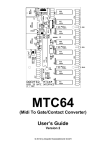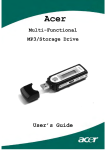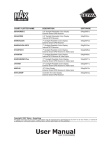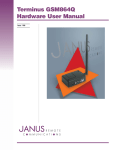Download GT863-PY Harware User Guide
Transcript
GT863-PY Hardware User Guide 1vv0300737 Rev.1 - 20/09/06 GT863-PY Hardware User Guide 1vv0300737 Rev.1 20/09/06 This document is relating to the following products: Model GT863-PY P/N 3990150466 Reproduction forbidden without Telit Communications S.p.A. written authorization - All Right reserved page 2 of 16 GT863-PY Hardware User Guide 1vv0300737 Rev.1 20/09/06 Contents 1 Overview ............................................................................................................................................ 5 2 Power Supply .................................................................................................................................... 6 2.1 Power Connector ....................................................................................................................................6 2.2 Power Supply Requirements .................................................................................................................6 2.2.1 3 4 2.3 Turning ON the GT863-PY ...................................................................................................................6 2.4 Turning OFF the GT863-PY .................................................................................................................7 Antenna ............................................................................................................................................. 8 3.1 GSM Antenna Requirements ................................................................................................................8 3.2 GSM Antenna - installation Guidelines................................................................................................9 Serial Ports...................................................................................................................................... 10 4.1 5 Maximum Consumptions ..................................................................................................................................6 MODEM SERIAL PORT ....................................................................................................................10 General Purpose I/O....................................................................................................................... 11 5.1 Logic level specifications ......................................................................................................................11 5.2 Using a GPIO pad as INPUT...............................................................................................................12 5.3 Using a GPIO pad as OUTPUT...........................................................................................................12 5.4 Using the Alarm Output GPIO6 .........................................................................................................12 5.5 Using the Buzzer Output GPIO7 ........................................................................................................12 6 Conformity Assessment Issues ....................................................................................................... 14 7 SAFETY RECOMMANDATIONS ................................................................................................ 15 Document Change Log .......................................................................................................................... 16 Reproduction forbidden without Telit Communications S.p.A. written authorization - All Right reserved page 3 of 16 GT863-PY Hardware User Guide 1vv0300737 Rev.1 20/09/06 DISCLAIMER The information contained in this document is proprietary information of Telit Communications S.p.A.. Telit Communications S.p.A. makes every effort to ensure the quality of the information it makes available. Notwithstanding the foregoing, Telit Communications S.p.A. does not make any warranty as to the information contained herein, and does not accept any liability for any injury, loss or damage of any kind incurred by use of or reliance upon the information. Telit Communications S.p.A. disclaims any and all responsibility for the application of the devices characterized in this document, and notes that the application of the device must comply with the safety standards of the applicable country, and where applicable, with the relevant wiring rules. Telit Communications S.p.A. reserves the right to make modifications, additions and deletions to this document at any time and without notice. © 2006 Telit Communications S.p.A. Reproduction forbidden without Telit Communications S.p.A. written authorization - All Right reserved page 4 of 16 GT863-PY Hardware User Guide 1vv0300737 Rev.1 20/09/06 1 Overview The aim of this document is the description of some hardware solutions useful for developing a product with the Telit GT863-PY Terminal. In this document all the basic functions of a mobile phone will be taken into account; for each one of them a proper hardware solution will be suggested and eventually the wrong solutions and common errors to be avoided will be evidenced. Obviously this document cannot embrace the whole hardware solutions and products that may be designed. The wrong solutions to be avoided shall be considered as mandatory, while the suggested hardware configurations shall not be considered mandatory, instead the information given shall be used as a guide and a starting point for properly developing your product with the Telit GT863-PY Terminal. For further hardware details that may not be explained in this document refer to the Telit GT863-PY Product Description document where all the hardware information is reported. NOTICE GT863-PY GT863-PY GT863-PY GT863-PY GT863-PY GT863-PY GT863-PY The information presented in this document is believed to be accurate and reliable. However, no responsibility is assumed by Telit Communication S.p.A. for its use, nor any infringement of patents or other rights of third parties which may result from its use. No license is granted by implication or otherwise under any patent rights of Telit Communication S.p.A. other than for circuitry embodied in Telit products. This document is subject to change without notice. Reproduction forbidden without Telit Communications S.p.A. written authorization - All Right reserved page 5 of 16 GT863-PY Hardware User Guide 1vv0300737 Rev.1 20/09/06 2 Power Supply 2.1 Power Connector FRONT VIEW The power connector is available on the left side of the terminal. Pin description: • GND = Ground reference @ 1.2A min, low ripple (120 mV) • Input power = 9 - 24V • Power Good = GPIO3 input (CMOS 2.8) GND GND Power Good Input Power 2.2 Power Supply Requirements The GT863-PY is powered through a Molex 4 pin connector (part no.: 43045-0400) It must be plugged to the POWER connector. • Input voltage range: 9 – 24V (Nominal Voltage : 12V ) • Input current: 8mA in idle mode, 110mA in communication GSM 1800/1900 @ 12V • The Supply must be provided by a short circuit protection • The Supply Cable must be provided by a Fuse in series (2A). 2.2.1 Maximum Consumptions Avg. consumption (9V Avg. consumption (9V Peak consumption (9V supply , active call in GSM pow lev 5, 1 TS): 160mA supply , active call in GSM pow lev 5, 2 TS): 250mA supply , active call in GSM pow lev ): 1280mA 2.3 Turning ON the GT863-PY To turn on the GT863-PY is sufficient to plug the power supply to the “POWER” connector. The module will automatically switch on itself. Reproduction forbidden without Telit Communications S.p.A. written authorization - All Right reserved page 6 of 16 GT863-PY Hardware User Guide 1vv0300737 Rev.1 20/09/06 2.4 Turning OFF the GT863-PY This could be done only switching off the power supply applied to the “POWER” connector of GT863PY. Reproduction forbidden without Telit Communications S.p.A. written authorization - All Right reserved page 7 of 16 GT863-PY Hardware User Guide 1vv0300737 Rev.1 20/09/06 3 Antenna The antenna connector is available on the left side of the terminal. It is Female SMA connector. 3.1 GSM Antenna Requirements The antenna for a Telit GT863-PY device shall fulfil the following requirements: ANTENNA REQUIREMENTS Frequency range Bandwidth Gain Impedance Input power VSWR absolute max VSWR recommended Standard Dual Band GSM/DCS frequency range or Standard Quad Band GSM/DCS/PCS frequency range if used for all four bands 70 MHz in GSM850, 80 MHz in GSM & 170 MHz in DCS & 140 MHz PCS band Gain < 3dBi 50 ohm > 2 W peak power <= 10:1 <= 2:1 This device is to be used only for mobile and fixed application. The antenna(s) used for this transmitter must be installed to provide a separation distance of at least 20 cm from all persons and must not be co-located or operating in conjunction with any other antenna or transmitter. End-Users must be provided with transmitter operation conditions for satisfying RF exposure compliance. OEM integrators must ensure that the end user has no manual instructions to remove or install the GT863-PY Terminal. Antennas used for this OEM module must not exceed 3dBi gain for mobile and fixed operating configurations. Reproduction forbidden without Telit Communications S.p.A. written authorization - All Right reserved page 8 of 16 GT863-PY Hardware User Guide 1vv0300737 Rev.1 20/09/06 3.2 GSM Antenna - installation Guidelines • • • • Install the antenna in a place covered by the GSM signal. The Antenna must be installed to provide a separation distance of at least 20 cm from all persons and must not be co-located or operating in conjunction with any other antenna or transmitter; Antenna shall not be installed inside metal cases Antenna shall be installed also according Antenna manufacturer instructions. Reproduction forbidden without Telit Communications S.p.A. written authorization - All Right reserved page 9 of 16 GT863-PY Hardware User Guide 1vv0300737 Rev.1 20/09/06 4 Serial Ports The serial port on the Telit GT863-PY is the core of the interface between the module and OEM hardware. 4.1 MODEM SERIAL PORT The RS-232 port is available through D-TYPE 9 pin connector The main characteristics are: Baud rate from 300 to 115,200 bits/s Autobauding (300 to 38,400 bits/s) Short circuit (to Ground) protection on all outputs. Input voltage range : -12V to +12V Pin out (refers to DTE side): Pin5 Pin1 Pin 1 = DCD Output Pin 2 = RX Output Pin 3 = TX Input Pin 4 = DTR Input Pin 5 = Ground Pin 6 = DSR Output Pin 7 = RTS Input Pin 8 = CTS Output Pin 9 = RI Output To connect to a PC a pin to pin, 9 pin cable needed with D type connectors (male & female) on both sides. Pin9 Reproduction forbidden without Telit Communications S.p.A. written authorization - All Right reserved Pin6 page 10 of 16 GT863-PY Hardware User Guide 1vv0300737 Rev.1 20/09/06 5 General Purpose I/O The general purpose I/O pads can be configured to act in three different ways: - input - output - alternate function (internally controlled) Input pads can only be read and report the digital value (high or low) present on the pad at the read time; output pads can only be written or queried and set the value of the pad output; an alternate function pad is internally controlled by the GT863-PY firmware and acts depending on the function implemented. • • • • GPIO4 supports all three modes GPIO5 supports all three modes and can be input, output, RFTX monitor output (Alternate function) GPIO6 supports all three modes and can be input, output, alarm output (Alternate function) GPIO7 supports all three modes and can be input, output, buzzer output (Alternate function) All GPIO pads are 2.8V CMOS signals and their interface levels are the same specified in the paragraph 5.1 5.1 Logic level specifications The following table shows the logic level specifications used in the interface circuits: Absolute Maximum Ratings -Not Functional Parameter Min Max Input level on any digital pin when on -0.3V +3.6V Input voltage on analog pins when on -0.3V +3.0 V Operating Range - Interface levels (2.8V CMOS) Level Min Max Input high level 2.1V 3.3V Input low level Output high level Output low level 0V 2.2V 0V 0.5V 3.0V 0.35V Reproduction forbidden without Telit Communications S.p.A. written authorization - All Right reserved page 11 of 16 GT863-PY Hardware User Guide 1vv0300737 Rev.1 20/09/06 5.2 Using a GPIO pad as INPUT The GPIO pads, when used as inputs, can be connected to a digital output of another device and report its status, provided this device has interface levels compatible with the 2.8V CMOS levels of the GPIO. If the digital output of the device to be connected with the GPIO input pad has interface levels different from the 2.8V CMOS, then it can be connected to GPIO1 or can be buffered with an open collector transistor, provided with a 47KΩ pull-up resistor. 5.3 Using a GPIO pad as OUTPUT The GPIO pads, when used as outputs, can drive 2.8V CMOS digital devices or compatible hardware. When set as outputs, the pads have a push-pull output and therefore the pull-up resistor may be omitted. 5.4 Using the Alarm Output GPIO6 The GPIO6 pad, when configured as Alarm Output, is controlled by the GT863-PY Terminal and will rise when the alarm starts and fall after the issue of a dedicated AT command. This output can be used to power up the GT863-PY controlling microcontroller or application at the alarm time, giving you the possibility to program a timely system wake-up to achieve some periodic actions and completely turn off the application during sleep periods. 5.5 Using the Buzzer Output GPIO7 The GPIO7 pad, when configured as Buzzer Output, is controlled by the GT863-PY Terminal and will drive with appropriate square waves a Buzzer driver. This permits to your application to easily implement Buzzer feature with ringing tones or melody played at the call incoming, tone playing on SMS incoming or simply playing a tone or melody when needed by your application. A sample interface scheme is included below to give you an idea of how to interface a Buzzer to the GPIO7: Reproduction forbidden without Telit Communications S.p.A. written authorization - All Right reserved page 12 of 16 GT863-PY Hardware User Guide 1vv0300737 Rev.1 20/09/06 NOTE: To correctly drive a buzzer a driver must be provided, its characteristics depend on the Buzzer and for them refer to your buzzer vendor. Reproduction forbidden without Telit Communications S.p.A. written authorization - All Right reserved page 13 of 16 GT863-PY Hardware User Guide 1vv0300737 Rev.1 20/09/06 6 Conformity Assessment Issues The GT863-PY Terminal is assessed to be conform to the R&TTE Directive as stand-alone products, so If the module is installed in conformance with Dai Telecom installation instructions require no further evaluation under Article 3.2 of the R&TTE Directive and do not require further involvement of a R&TTE Directive Notified Body for the final product. In all other cases, or if the manufacturer of the final product is in doubt then the equipment integrating the radio module must be assessed against Article 3.2 of the R&TTE Directive. In all cases assessment of the final product must be made against the Essential requirements of the R&TTE Directive Articles 3.1(a) and (b), safety and EMC respectively, and any relevant Article 3.3 requirements. The GT863-PY Terminal is conform with the following European Union Directives: • R&TTE Directive 1999/5/EC (Radio Equipment & Telecommunications Terminal Equipments) • Low Voltage Directive 73/23/EEC and product safety • Directive 89/336/EEC for conformity for EMC In order to satisfy the essential requisite of the R&TTE 99/5/EC directive, the GT863-PY Terminal is compliant with the following standards: • • • GSM (Radio Spectrum). Standard: EN 301 511 and 3GPP 51.010-1 EMC (Electromagnetic Compatibility). Standards: EN 301 489-1 and EN 301 489-7 LVD (Low Voltage Directive) Standards: EN 60 950 In this document and the Hardware User Guide, Software User Guide all the information you may need for developing a product meeting the R&TTE Directive is included. Reproduction forbidden without Telit Communications S.p.A. written authorization - All Right reserved page 14 of 16 GT863-PY Hardware User Guide 1vv0300737 Rev.1 20/09/06 7 SAFETY RECOMMANDATIONS READ CAREFULLY Be sure the use of this product is allowed in the country and in the environment required. The use of this product may be dangerous and has to be avoided in the following areas: Where it can interfere with other electronic devices in environments such as hospitals, airports, aircrafts, etc Where there is risk of explosion such as gasoline stations, oil refineries, etc It is responsibility of the user to enforce the country regulation and the specific environment regulation. Do not disassemble the product; any mark of tampering will compromise the warranty validity. We recommend following the instructions of the hardware user guides for a correct wiring of the product. The product has to be supplied with a stabilized voltage source and the wiring has to be conforming to the security and fire prevention regulations. The product has to be handled with care, avoiding any contact with the pins because electrostatic discharges may damage the product itself. Same cautions have to be taken for the SIM, checking carefully the instruction for its use. Do not insert or remove the SIM when the product is in power saving mode. The system integrator is responsible of the functioning of the final product; therefore, care has to be taken to the external components of the module, as well as of any project or installation issue, because the risk of disturbing the GSM network or external devices or having impact on the security. Should there be any doubt, please refer to the technical documentation and the regulations in force. Every module has to be equipped with a proper antenna with specific characteristics. The antenna has to be installed with care in order to avoid any interference with other electronic devices and has to guarantee a minimum distance from the body (20 cm). In case of this requirement cannot be satisfied, the system integrator has to assess the final product against the SAR regulation. The European Community provides some Directives for the electronic equipments introduced on the market. All the relevant information’s are available on the European Community website: http://europa.eu.int/comm/enterprise/rtte/dir99-5.htm The text of the Directive 99/05 regarding telecommunication equipments is available, while the applicable Directives (Low Voltage and EMC) are available at: http://europa.eu.int/comm/enterprise/electr_equipment/index_en.htm Reproduction forbidden without Telit Communications S.p.A. written authorization - All Right reserved page 15 of 16 GT863-PY Hardware User Guide 1vv0300737 Rev.1 20/09/06 Document Change Log Revision Date ISSUE #0 05/09/06 ISSUE #1 20/09/06 Changes First release Added requirement for fuse on supply cable Supply with short circuit protection Added Maximum consumption paragraph Added GSM850 Antenna Bandwidth (70MHz) Reproduction forbidden without Telit Communications S.p.A. written authorization - All Right reserved page 16 of 16



























